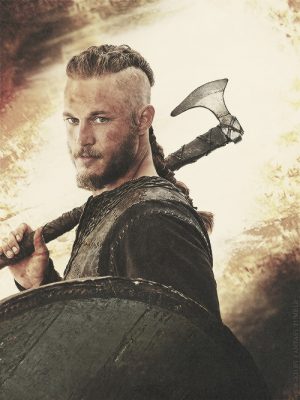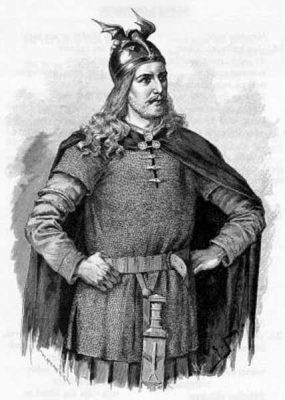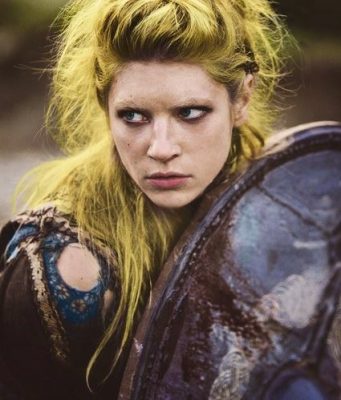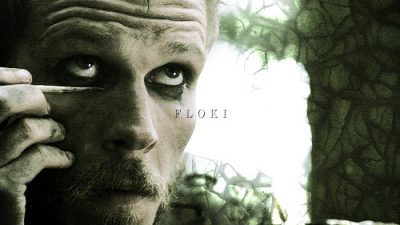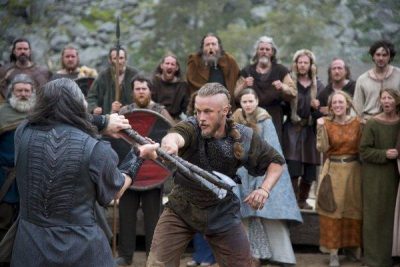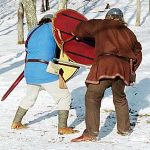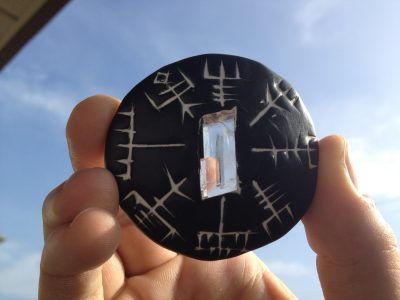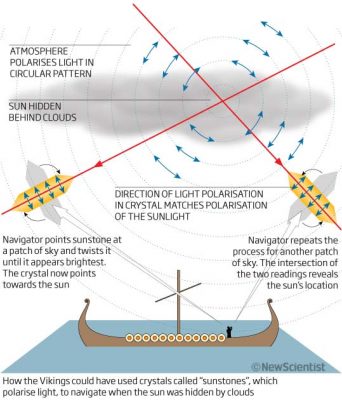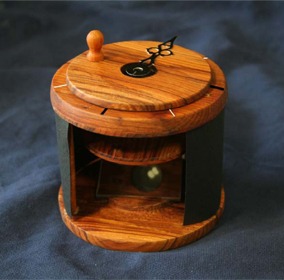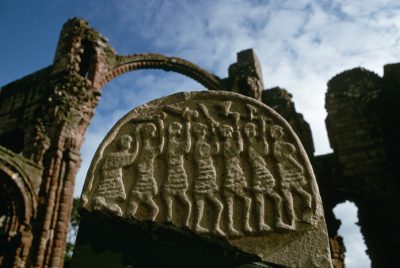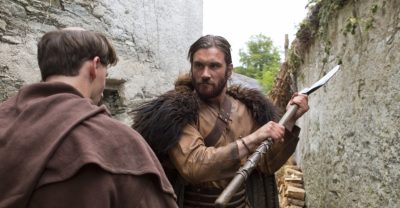Everybody is talking about season 2 of Vikings which premiered on History Channel just a few weeks ago. Loosely based on the famous Norse saga known as the Saga of Ragnar Lodbrok, which was a sequel to the Völsung Saga, the series has gathered quite a following and various blogs and social media sites are a buzz with all things Vikings related. The show is well cast and the acting is well done which has given the series much praise. There has also been a lot of gruff given to the series by historians who have issue with some of the accuracies -- or inaccuracies -- that the television show presents. As with any historical adaptation there is likely to be flaws mixed in with the facts. Regardless of where Vikings may go astray, the general feel and mood representing Dark Ages Scandinavia seems to ring true -- more or less!
This week's post is going to look at fun facts, accuracies, flaws and historical debates surrounding the show Vikings. Grab your drinking horn, fill it with ale then sit down and listen to some epic folk metal as you read this article.
Ragnar Lodbrok
The show depicts Ragnar as a Norseman, but according to the sagas Ragnar was the son of Swedish king Sigmund Hring and also a relative of the Danish king Gudfred. Like many Scandinavian and Celtic tales, mythology and legend weaves itself into actual history. Though the sons of Ragnar Lodbrok (which include Ivar the Boneless, Björn Ironside, Halfdan Ragnarsson, Sigurd Snake-in-the-Eye, and Ubba) were actual historical figures, it is unknown if Ragnar himself actually existed, or if he was more than one person. Many of the tales associated with Ragnar Lodbrok coincide with the deeds of other historical Viking rulers and heroes.
FUN FACT: The name Lodbrok litterally translates into "hairy trousers" or "hairy breeches." Not exactly a name to instil fear; however based on the stories told of Raganr, he didn't need a badass name as his actions spoke louder then his hairy pants!
Makeup & Eyeliner
So, what about all of that eyeliner we see in the show? How historically accurate can that be? Quite accurate, actually! You can even find records from Middle Eastern visitors to Norse encampments stating this to be true. Vikings used a type of eyeliner known as kohl which was a dark-colored powder made of crushed antimony, burnt almonds, lead, oxidized copper, ochre, ash, malachite and chrysocolla. It helped keep the harsh glare of the sun from damaging one's eyesight while also increasing the dramatic sex appeal of the wearer.
Ibrahim Al-Tartushi, an Arab traveler who visited the Viking trading hub of Hedeby in 950AD wrote: "there is also an artificial make-up for the eyes, when they use it beauty never fades, on the contrary it increases in men and women as well." So there you have it, eyeliner on both men and women is as sexy today as it was over a thousand years ago.
Combat & Fighting Styles
Most shows and movies about Vikings tend to get one very key thing wrong about Viking combat. It was their shields that were used as the primary weapon and their swords were their secondaries.
As Viking combat expert and fellow Historical European Martial Artist, Roland Warzecha said: "The sword does the damage but is tactically only secondary. Because of the way these weapons were used in conjunction, Viking Age sword & shield combat was based on shield binds, and blade-on-blade contacts hardly ever occurred."
Navigating With the Sunstone
This has been one of the most widely debated topics by historians about the television show. Long before History Channel released the series, historians had been debating whether Vikings used a common calcite crystal, also known as an Icelandic spar, to find the sun in the high latitudes where they would have had to navigate despite long twilights and cloudy, overcast skies. "The Vikings could have discovered this, simply by choosing a transparent crystal and looking through it through a small hole in a screen," study researcher Guy Ropars wrote. "The understanding of the complete mechanism and the knowledge of the polarization of light is not necessary."
One of these crystals has yet to be discovered in any Viking settlements, however one was recently discovered in an Elizabethan shipwreck from 1592 in the English Channel. Historians and researchers are currently trying to confirm whether or not this crystal could have been used to find the sun when it was out of sight, which they think might be true; as a large cannon on board the ship would have interfered with a magnetic compass. Regardless of whether or not the Vikings used such stones, it is clear that other nearby cultures used them to navigate the seas.
Costumes & Armour
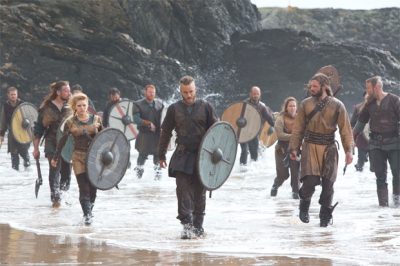
Everyone can agree that the actors portraying the characters in the series look pretty awesome. However, the clothing they wear is unfortunately not very historically accurate. The costumes they wear look more like something one would find in a post apocalyptic, Mad Max-esque story as opposed to a 9th century Scandinavian village.
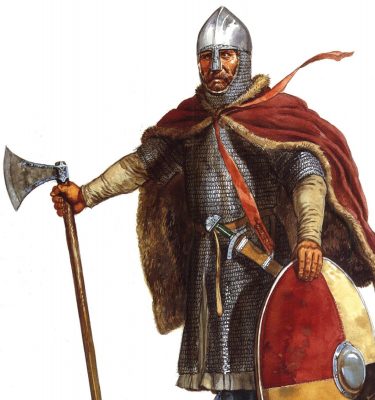
Also, the Viking raiders in the show seem to be wearing a surprising lack of armour or protective gear. Viking warriors and shield maidens historically would wear shirts of maille or leather in battle; as well as iron helmets. In the show when Ragnar and his crew land in England, the Northumbrian's seem to be sporting the right armour and helmets, but our raiding Vikings are sorely lacking!
Discovering England & the Raid on Lindisfarne
Ok, first off, the idea that Vikings in the 9th century did not know that England and other "lands to the West" existed is just plain ridiculous. In the TV series, our hero Ragnar Lodbrok is credited for discovering what we now know as modern day Britain and that just is not true. Scandinavians had been in contact with and trading with the Saxons and Frisians in the North Sea for centuries.
The sacking of the Monastery on Lindisfarne was historically the first attack on English soil. However, this happened back in 793 AD, and if we follow the saga of Ragnar Lodbrok, he is said to have died in Northumbria around 865 AD. In the television series Ragnar Lodbrok is depicted to be in his late twenties or early thirties when he raids the monestary. Somehow I doubt that he died at the ripe old age of ninety-something-or-other. Also, one of the stories credited to Ragnar Lodbrok is that he sacked the city of Paris in 845 AD which would have made him one hearty senior citizen if he pulled that off following the timeline of the television series!
In Conclusion
Despite some of the historical inaccuracies, Vikings is a great television series. It is super fun to watch and if you are an amateur historian it is great to discuss and debate the facts and foibles from each episode. New episodes air each Thursday on the History Channel and I hope you keep some of the topics explored in this article in mind while you're watching.
